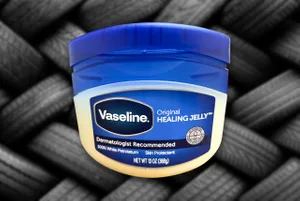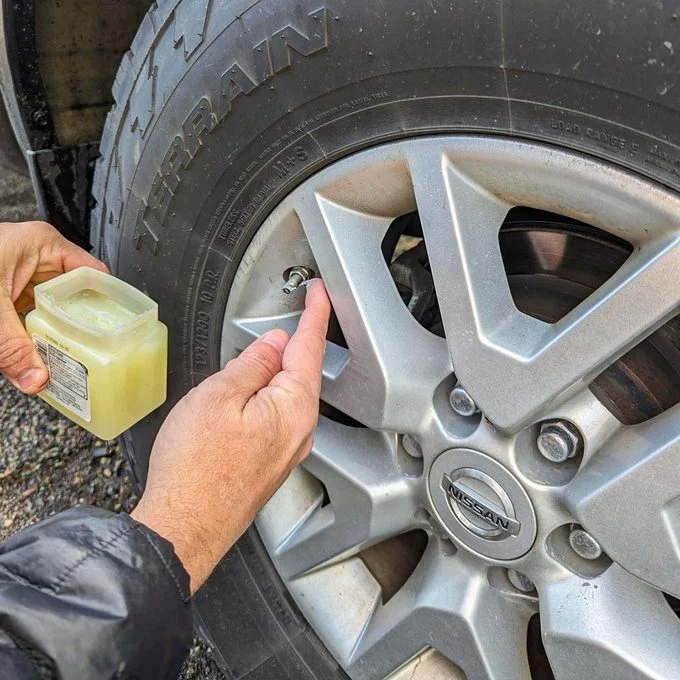Car owners love a good hack—especially one that promises to solve everyday issues with simple household items. One popular claim circulating online suggests that applying Vaseline to your tire’s valve stem can prevent air loss, particularly in cold weather. But does this trick actually work, or is it just another myth that doesn’t hold up under scrutiny? Let’s dive into the facts and separate truth from fiction.

Why Do Tires Lose Air Pressure in Winter?
Before discussing the Vaseline hack, it’s important to understand why tires lose air pressure—especially in colder temperatures.
When the temperature drops, air molecules inside the tire move more slowly and take up less space, reducing air pressure. According to Consumer Reports, for every 10°F drop in temperature, tire pressure can decrease by approximately 1 PSI (pound per square inch).
Additionally, natural air loss occurs over time due to tiny leaks in the valve stems, beads, or even porous areas of the rubber. Keeping tires properly inflated is critical to prevent excessive wear, reduced fuel efficiency, and increased risk of blowouts.
What Is the Vaseline Tire Hack?
The Vaseline tire hack involves applying a small amount of petroleum jelly to the valve stem and its threads before securing the valve cap. The idea is that this creates a seal, preventing air from escaping while also protecting the valve from dirt, moisture, and corrosion.
At first glance, the logic behind the hack seems reasonable. After all, many professional mechanics use lubricants and sealants to maintain tire components. But does Vaseline provide the same benefits?
Does Vaseline Really Keep Tires from Losing Air Pressure?
The short answer: not really, and certainly not in the long run.
While Vaseline might create a temporary seal, preventing minor leaks or keeping debris out of the valve, its effectiveness is limited for several reasons:
- Vaseline Breaks Down Under Heat – Tires heat up as you drive, even in cold weather. Vaseline, a petroleum-based product, softens and turns into a thinner, oily substance when exposed to heat. This reduces its ability to create a lasting seal, and it may even drip away from the valve stem over time.
- Centrifugal Force Can Spread the Vaseline – When the wheels spin at high speeds, Vaseline could spread onto the wheel and tire, attracting dust, dirt, and road grime. This can create a sticky mess that may lead to long-term maintenance issues.
- Potential Damage to Rubber Components – Vaseline is known to degrade certain types of rubber over time. If it seeps into the rubber seals inside the valve stem, it could cause premature wear and actually increase air loss instead of preventing it.
- Minimal Impact on Air Retention – The majority of air loss in tires occurs through natural diffusion, small leaks at the bead (where the tire meets the wheel), or slow leaks from tiny punctures. A small dab of Vaseline on the valve stem won’t address these larger issues.

Potential Risks of Using Vaseline on Tires
While this hack may seem harmless, it comes with some unintended risks:
- Slippery Brakes? Although unlikely, any petroleum-based substance that drips onto the brake rotors could reduce braking effectiveness.
- Corrosion Concerns Metal valve caps, when combined with Vaseline, may cause increased corrosion over time. This can make it difficult to remove the valve cap when necessary.
- TPMS Sensor Damage Many modern cars have a Tire Pressure Monitoring System (TPMS). If Vaseline seeps into the TPMS valve stem, it could interfere with the sensor’s function, leading to inaccurate readings or costly repairs.
What Actually Works to Prevent Air Loss?
If you’re looking for a real solution to maintaining proper tire pressure, consider these alternatives:
1. Use Silicone-Based Lubricants Instead of Vaseline
Unlike petroleum jelly, silicone-based lubricants don’t degrade rubber components. Applying a thin layer of dielectric grease or silicone gel to the valve stem threads can help keep out dirt and moisture without causing long-term damage.
2. Replace Worn Valve Stems
If your tire valves are old, cracked, or corroded, they may be allowing air to escape. Replacing them is an inexpensive and effective way to maintain proper air pressure.
3. Upgrade to Valve Caps with O-Rings
High-quality valve caps with built-in rubber O-rings provide a much better seal than standard plastic caps. They help prevent dirt, moisture, and air leaks.
4. Regularly Check and Inflate Tires
No hack can replace the importance of regular tire maintenance. Check your tire pressure at least once a month and before long trips. Use a reliable digital gauge and fill your tires to the manufacturer’s recommended PSI.
5. Use Tire Sealants for Small Leaks
If you suspect a slow leak, consider using a tire sealant designed for long-term use. Products like Slime or Fix-a-Flat can temporarily seal minor punctures and prevent air loss.
Final Verdict: Is the Vaseline Tire Hack Worth Trying?
While applying Vaseline to your tire valves might provide a temporary seal against dirt and moisture, it’s not a long-term solution for preventing air loss. In fact, it could cause more harm than good by softening rubber components, attracting debris, and potentially interfering with TPMS sensors.
If you’re serious about maintaining proper tire pressure, focus on proven methods like replacing old valve stems, using high-quality valve caps, and regularly checking your PSI. In the end, proper tire maintenance—not a quick fix—will keep your tires inflated and your vehicle running safely.